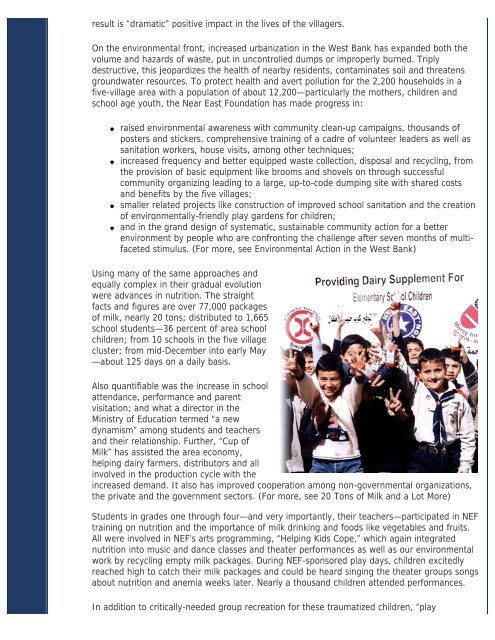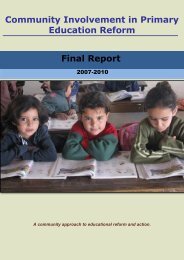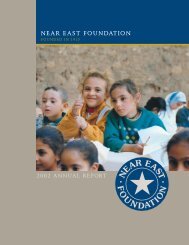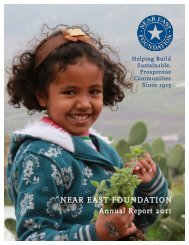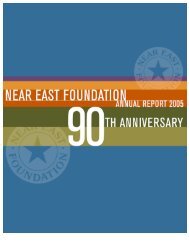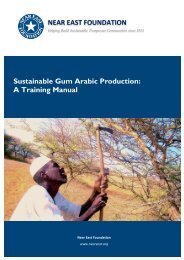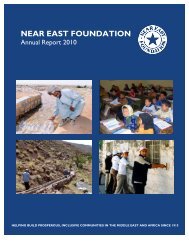NEF 2004 Annual Report - Near East Foundation
NEF 2004 Annual Report - Near East Foundation
NEF 2004 Annual Report - Near East Foundation
Create successful ePaper yourself
Turn your PDF publications into a flip-book with our unique Google optimized e-Paper software.
esult is “dramatic” positive impact in the lives of the villagers.<br />
On the environmental front, increased urbanization in the West Bank has expanded both the<br />
volume and hazards of waste, put in uncontrolled dumps or improperly burned. Triply<br />
destructive, this jeopardizes the health of nearby residents, contaminates soil and threatens<br />
groundwater resources. To protect health and avert pollution for the 2,200 households in a<br />
five-village area with a population of about 12,200—particularly the mothers, children and<br />
school age youth, the <strong>Near</strong> <strong>East</strong> <strong>Foundation</strong> has made progress in:<br />
●<br />
●<br />
●<br />
●<br />
raised environmental awareness with community clean-up campaigns, thousands of<br />
posters and stickers, comprehensive training of a cadre of volunteer leaders as well as<br />
sanitation workers, house visits, among other techniques;<br />
increased frequency and better equipped waste collection, disposal and recycling, from<br />
the provision of basic equipment like brooms and shovels on through successful<br />
community organizing leading to a large, up-to-code dumping site with shared costs<br />
and benefits by the five villages;<br />
smaller related projects like construction of improved school sanitation and the creation<br />
of environmentally-friendly play gardens for children;<br />
and in the grand design of systematic, sustainable community action for a better<br />
environment by people who are confronting the challenge after seven months of multifaceted<br />
stimulus. (For more, see Environmental Action in the West Bank)<br />
Using many of the same approaches and<br />
equally complex in their gradual evolution<br />
were advances in nutrition. The straight<br />
facts and figures are over 77,000 packages<br />
of milk, nearly 20 tons; distributed to 1,665<br />
school students—36 percent of area school<br />
children; from 10 schools in the five village<br />
cluster; from mid-December into early May<br />
—about 125 days on a daily basis.<br />
Also quantifiable was the increase in school<br />
attendance, performance and parent<br />
visitation; and what a director in the<br />
Ministry of Education termed “a new<br />
dynamism” among students and teachers<br />
and their relationship. Further, “Cup of<br />
Milk” has assisted the area economy,<br />
helping dairy farmers, distributors and all<br />
involved in the production cycle with the<br />
increased demand. It also has improved cooperation among non-governmental organizations,<br />
the private and the government sectors. (For more, see 20 Tons of Milk and a Lot More)<br />
Students in grades one through four—and very importantly, their teachers—participated in <strong>NEF</strong><br />
training on nutrition and the importance of milk drinking and foods like vegetables and fruits.<br />
All were involved in <strong>NEF</strong>’s arts programming, “Helping Kids Cope,” which again integrated<br />
nutrition into music and dance classes and theater performances as well as our environmental<br />
work by recycling empty milk packages. During <strong>NEF</strong>-sponsored play days, children excitedly<br />
reached high to catch their milk packages and could be heard singing the theater groups songs<br />
about nutrition and anemia weeks later. <strong>Near</strong>ly a thousand children attended performances.<br />
In addition to critically-needed group recreation for these traumatized children, “play


